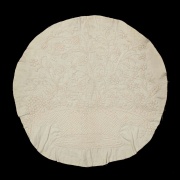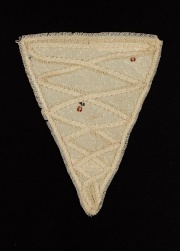Difference between revisions of "Tabby"
Jump to navigation
Jump to search
(username removed) |
(username removed) |
||
| Line 2: | Line 2: | ||
== Description == | == Description == | ||
| − | 1) An old British classification for a [http://cameo.mfa.org/materials/fullrecord.asp?name=plain | + | 1) An old British classification for a [http://cameo.mfa.org/materials/fullrecord.asp?name=plain%20weave plain weave] fabric (Tortora and Merkel 1996). Tabby is often woven with two warp and two weft threads to form a coarser fabric. |
| − | 2) A concrete made from ground [http://cameo.mfa.org/materials/fullrecord.asp?name=oyster | + | 2) A concrete made from ground [http://cameo.mfa.org/materials/fullrecord.asp?name=oyster%20shell oyster shells], [http://cameo.mfa.org/materials/fullrecord.asp?name=lime lime] obtained from burnt shells, and [http://cameo.mfa.org/materials/fullrecord.asp?name=sand sand]. Tabby was used by Spanish settlers in 16th century in Florida (Bucher 1996). It was in use until the mid-19th century in many coastal areas of the southeastern U.S. |
[[File:68.594-SC8117.jpg|thumb|]] | [[File:68.594-SC8117.jpg|thumb|]] | ||
| Line 15: | Line 15: | ||
== Additional Information == | == Additional Information == | ||
| − | P.Tortora, R.Merkel (eds.), ''Fairchild's Dictionary of Textiles'', Fairchild Publications, New York, 1996. | + | ° P.Tortora, R.Merkel (eds.), ''Fairchild's Dictionary of Textiles'', Fairchild Publications, New York, 1996. ° W. Bucher, ''Dictionary of Building Preservation'', John Wiley & Sons, New York, 1996. |
== Authority == | == Authority == | ||
| − | * | + | * Rosalie Rosso King, ''Textile Identification, Conservation, and Preservation'', Noyes Publications, Park Ridge, NJ, 1985 |
* ''Dictionary of Building Preservation'', Ward Bucher, ed., John Wiley & Sons, Inc., New York City, 1996 | * ''Dictionary of Building Preservation'', Ward Bucher, ed., John Wiley & Sons, Inc., New York City, 1996 | ||
Revision as of 07:23, 24 July 2013
Description
1) An old British classification for a plain weave fabric (Tortora and Merkel 1996). Tabby is often woven with two warp and two weft threads to form a coarser fabric.
2) A concrete made from ground oyster shells, lime obtained from burnt shells, and sand. Tabby was used by Spanish settlers in 16th century in Florida (Bucher 1996). It was in use until the mid-19th century in many coastal areas of the southeastern U.S.
Synonyms and Related Terms
1) tabby weave; plain weave; armure toile (Fr.)
2) tapia
Additional Information
° P.Tortora, R.Merkel (eds.), Fairchild's Dictionary of Textiles, Fairchild Publications, New York, 1996. ° W. Bucher, Dictionary of Building Preservation, John Wiley & Sons, New York, 1996.
Authority
- Rosalie Rosso King, Textile Identification, Conservation, and Preservation, Noyes Publications, Park Ridge, NJ, 1985
- Dictionary of Building Preservation, Ward Bucher, ed., John Wiley & Sons, Inc., New York City, 1996
- Fairchild's Dictionary of Textiles, Phyllis G.Tortora, Robert S. Merkel (eds.), Fairchild Publications, New York City, 7th edition, 1996
- Art and Architecture Thesaurus Online, http://www.getty.edu/research/tools/vocabulary/aat/, J. Paul Getty Trust, Los Angeles, 2000
- Wikipedia, the free encyclopedia, at http://www.wikipedia.com Comment: http://en.wikipedia.org/wiki/Tabby_%28cement%29 (Accessed Nov. 9, 2005)

